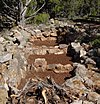Portal:Arizona/Selected Article/3
The known history of the Grand Canyon area stretches back 10,500 years when the first evidence for human presence in the area started. Native Americans have been living at Grand Canyon and in the area now covered by Grand Canyon National Park for at least the last 4,000 of those years. Anasazi, first as the Basketmaker culture and later as the more familiar Puebleoans, developed from the Desert Culture as they became less nomadic and more dependent on agriculture. A similar culture, the Cohonina, also lived in the canyon area. Drought in the late 13th century was the likely cause for both cultures to move on. Other cultures followed, including the Paiutes, Cerbat, and the Navajo, only to be later forced onto reservations by the United States Government. Under direction by conquistador Francisco Vázquez de Coronado to find the fabled Seven Cities of Cibola, Captain García López de Cárdenas led a party of Spanish soldiers with Hopi guides to the Grand Canyon in September of 1540. Not finding what they were looking for, they left. Over 200 years passed before two Spanish priests became the second party of non-Native Americans to see the canyon.

